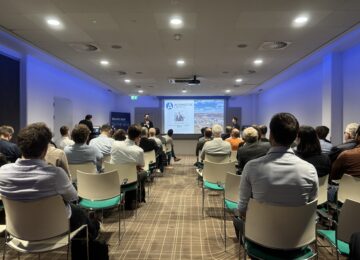Energy storage gets priority in queue
Last week, the ACM presented a broad package of measures to reduce grid congestion problems. The measures mainly focus on enabling flexible use of the electricity grid. This offers opportunities for accelerated adoption of energy storage in practice.
Prioritization framework queue
One of the measures published by the ACM focuses on the queuing of applications. The ACM has developed a prioritization framework that allows grid operators to prioritize projects that are of social value. So-called "congestion relievers," such as energy storage systems that add capacity for other users, are given first priority.
Energy Storage NL previously issued a view submitted to the public consultation on this proposal. Thus, after incorporating feedback from this consultation, the decision is now final. Grid operators are required to use the prioritization framework from Oct. 1, 2024.
Time-based transportation rates and alternative transportation rights
In addition, the ACM considered whether efficient grid use could be encouraged through the introduction of tariff incentives. To this end, two code proposals were submitted by the grid operators: a proposal for alternative transport rights (time-based and time-block contracts), and a proposal for time-based ('time of use') net rates. The proposals follow discussions between ESNL and the grid operators and from the Energy Storage Administrative Consultation. Combined, the two proposals could lead to a significant reduction in total network tariffs to about 65%.
The alternative transmission rights proposal is up for consultation through April 24. This code change should ensure that new contracts are available to better utilize the residual space on the grid. It would allow connected customers on the high-voltage grid to receive an exemption on their KW contracted, against a 15% time limit on their transmission capacity. For the lower grid levels, a discount is proposed depending on definable blocks of time in which a connected party can be curtailed. Both contract types are voluntary and will be handled in a separate queue depending on the local grid situation.
The proposal for time-dependent network tariffs has just been published for consultation, views can be submitted up to six weeks after publication. Large-scale consumers on the national high-voltage grid can receive discounts of up to 40% on their kWmax by using the grid at off-peak times. If this code change is implemented it will start to apply to all connected parties to the high-voltage grids.
Congestion Management
Congestion management rules are also further tightened. In congestion areas with feed-in congestion (too much generation), the grid operator must examine how much flexibility can be unlocked when the "participation obligation" is triggered, i.e. when the grid operator obliges connected parties in the congestion area to offer their flexibility for a fee. In addition, group CBCs are also becoming possible for connected parties larger than 1 MW and the ACM has set the deadlines for publishing congestion studies so that parties can get clarity more quickly on whether their submitted application can be honored.
Below is an overview of all the ACM's new measures against grid congestion
| Measure | Behavior | Perspective | Status |
| I. Non-firm capacity contracts. | Large consumers in congested areas are willing to reduce their consumption when necessary due to congestion. | Faster access and reward for smart grid use: saving approximately 50% in total grid costs. Utilize space remaining in congested areas | Final |
| II. Tightening participation obligation of private grids | Private grids are also required to participate in congestion management. | Creates more space for grid users. | Final (appeal) |
| III. Social prioritization | Certain projects that contribute to important societal interests are eligible for priority in the allocation of transmission capacity. | Limiting the impact of grid congestion to the achievement of important societal goals. | Final (open for appeal) |
| IV. Connection deadlines for large customers. | Grid operators in most cases are given up to 52 weeks to establish a connection, depending on the circumstances. | Concrete connection deadlines for large customers. | Final (open for appeal) |
| V. Time-of-use (high-voltage grid). | Large consumers on the national high-voltage grid voluntarily shift (part of) their consumption to quieter times. | Lower costs for consumers: saving up to about 15% on total grid costs. Creates space for other parties during rush hour. | Design (consultation phase) |
| VI. Alternative transmission right based on time duration (high-voltage grid) | Large consumers on the national high-voltage grid agree not to use the grid at peak times (maximum 15% of the time). | Faster access and reward for smart grid use: saving approximately 50% in total grid costs. Creates space for other parties during rush hour. | Design (consultation phase) |
| VII. Alternative transportation law based on time blocks (regional grids). | Large consumers on the regional distribution networks agree to use the grid only at agreed upon off-peak times. | Faster access and reward for smart grid use: savings can be as much as about 50% of total grid costs. Creates space for other parties during rush hour. | Design (consultation phase) |
| VIII. Clarifying participation obligation congestion management. | Clarify the conditions under which the grid operator can require grid users with a connection greater than 1 MW to offer congestion management services. | More certainty for the grid operator about the controllable power available in a congestion area to grant new transmission requests. | Design (consultation phase) |
| IX. Congestion management changes. | Grid operators should rather see controllable power from grid users as "available" and allow more renewable generation access to the grid. | Creates more space for importers (solar and wind). In addition, faster clarity on remaining space on the grid. Better rules for group cooperation (group CBC). | Final (open for appeal) |
| X. Use in time or lose it (GOTORK) | Large consumers and importing parties who do not use their capacity for a long time must return it in certain situations. | Unused capacity grid users will be released to other grid users. | Final (open for appeal) |





